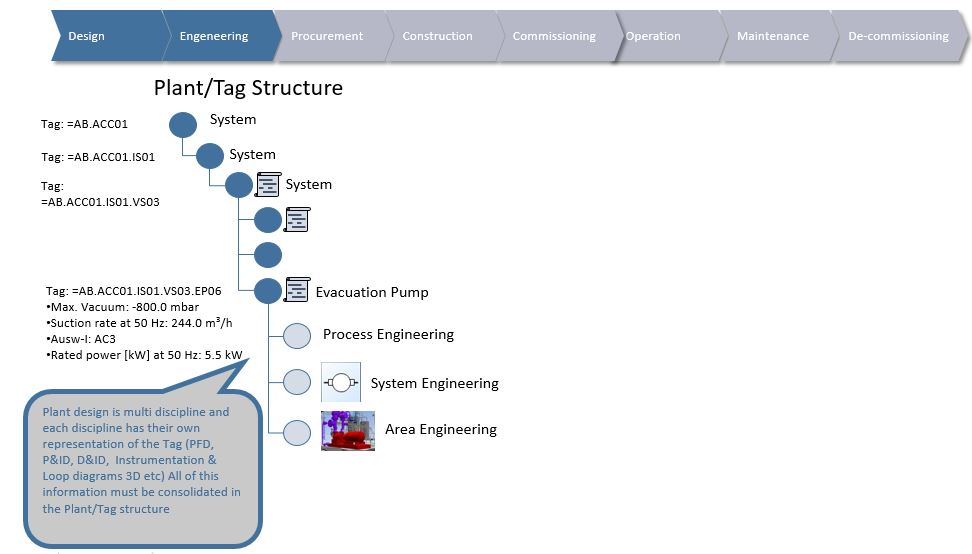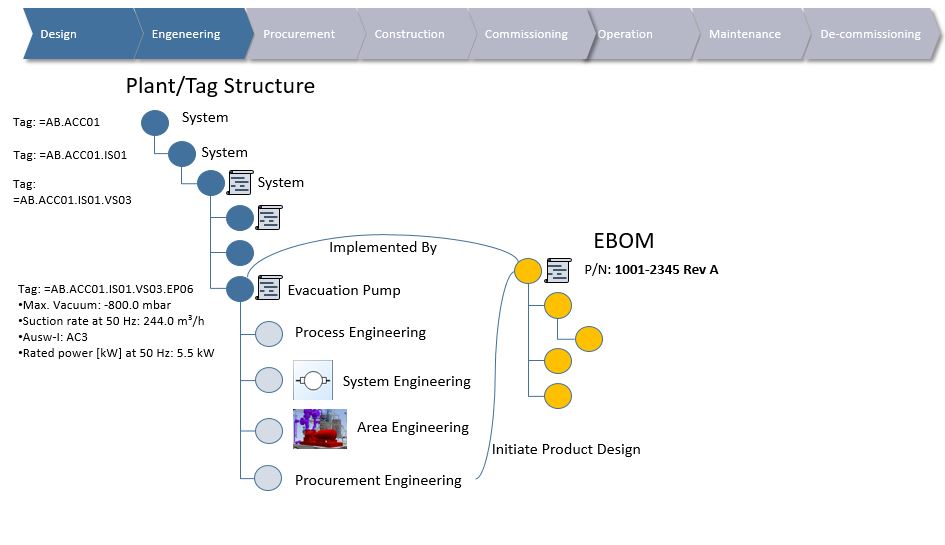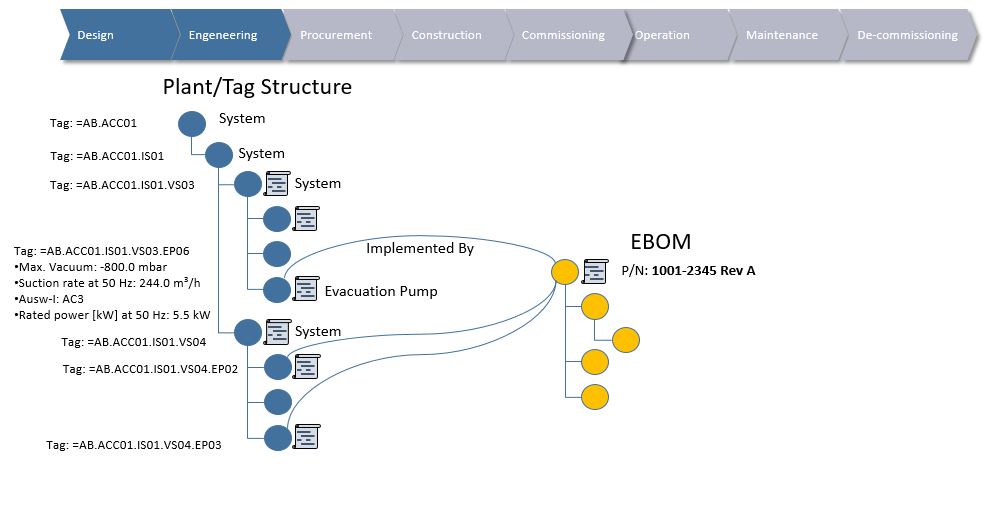
This post is a follow up of “Plant Information Management - What to manage?”.
It focuses on the needed collaboration between Plant Engineering (highly project intensive) and Product Engineering which ideally should be “off the shelf” or at least Configure To Order (CTO), but in reality is more often than not, Engineer To Order (ETO) or one-offs.
It focuses on the needed collaboration between Plant Engineering (highly project intensive) and Product Engineering which ideally should be “off the shelf” or at least Configure To Order (CTO), but in reality is more often than not, Engineer To Order (ETO) or one-offs.
More and more EPC’s (Engineering Procurement Construction companies), and product companies exposed to project intensive industries are focusing hard on ways to re-use product designs from one project to the next or even internally in the same project through various forms of configuration and clever use of master data, see “Engineering Master Data - Why is it different?”.
However, we will never get away from the fact that the product delivery in a capital project will always have to fulfill specific requirements from Plant Engineering, and especially in safety classed areas of the plant.
If you look at the blue object structure, it represents a consolidated view of multi-discipline plant engineering. The system might consist of several pumps, heat exchangers, sensors, instrumentation and pipes, but we are going to focus on a specific tag and it’s requirements, namely one of the pumps in the system.
However, we will never get away from the fact that the product delivery in a capital project will always have to fulfill specific requirements from Plant Engineering, and especially in safety classed areas of the plant.
If you look at the blue object structure, it represents a consolidated view of multi-discipline plant engineering. The system might consist of several pumps, heat exchangers, sensors, instrumentation and pipes, but we are going to focus on a specific tag and it’s requirements, namely one of the pumps in the system.
At one point in the plant engineering process the design is deemed fit for project procurement to start investigating product designs that might fulfill the requirements stated in the plant system design.
If the plant design is made by an EPC that does not own any product companies, the representing product is typically a single article or part with associated preferred vendors/manufacturers who might be able to produce such a product or have it in stock. If the EPC does own product companies, the representing product might be a full product design. In other words a full Engineering Bill Of Material (EBOM) of the product.
This is where it becomes very interesting indeed because the product design (EBOM) is generic in nature. It represents a blueprint or mold if you will, used to produce many physical products or instances of the product design. The physical products typically have serial numbers, and you are able to touch them. However, due to requirements from the Owner/Operator, the EPC will very often dictate both project and tag specific documentation from the product company supplying to the project, which in turn often leads to replication of the product designs X number of times to achieve compliance with the documentation requirements in the project (Documentation For Installation and Operations).
If the plant design is made by an EPC that does not own any product companies, the representing product is typically a single article or part with associated preferred vendors/manufacturers who might be able to produce such a product or have it in stock. If the EPC does own product companies, the representing product might be a full product design. In other words a full Engineering Bill Of Material (EBOM) of the product.
This is where it becomes very interesting indeed because the product design (EBOM) is generic in nature. It represents a blueprint or mold if you will, used to produce many physical products or instances of the product design. The physical products typically have serial numbers, and you are able to touch them. However, due to requirements from the Owner/Operator, the EPC will very often dictate both project and tag specific documentation from the product company supplying to the project, which in turn often leads to replication of the product designs X number of times to achieve compliance with the documentation requirements in the project (Documentation For Installation and Operations).
So, even if it is exactly the same product design it ends up being copied each time there is a project specific delivery. This often happens even if let’s say 40 pumps are being supplied by the same vendor to the same project, as responses to the requirements on 40 different tags in the plant design……
Needless to say it becomes a lot of Engineering Bill Of Materials in order to comply with documentation requirements in capital projects. Even worse, for the product companies it becomes virtually impossible to determine exactly what they have delivered each time, since it is different Engineering Bills Of Materials all the time, yet 97% of the information might be the same. The standardized product has now become an Engineer To Order product.
So how is it possible to avoid this monstrous duplication of work?
More and more companies are looking into ways to make use of data structures used in different contexts. The contexts might be different deliveries to the same project or across multiple projects, but if one is able to identify and separate the generic information from what information that needs to be project specific it is also possible to facilitate re-use.
Needless to say it becomes a lot of Engineering Bill Of Materials in order to comply with documentation requirements in capital projects. Even worse, for the product companies it becomes virtually impossible to determine exactly what they have delivered each time, since it is different Engineering Bills Of Materials all the time, yet 97% of the information might be the same. The standardized product has now become an Engineer To Order product.
So how is it possible to avoid this monstrous duplication of work?
More and more companies are looking into ways to make use of data structures used in different contexts. The contexts might be different deliveries to the same project or across multiple projects, but if one is able to identify and separate the generic information from what information that needs to be project specific it is also possible to facilitate re-use.
The image above shows how a generic product design (EBOM) is able to fulfill three different project specific tags or functional locations in a plant. Naturally three physical instances or serial numbers must then be manufactured based on the generic product design, but since we have the link or relationship between the project specific requirements (the tags) and the generic (the EBOM), one can generate project specific data and documentation without making changes to the generic representation of the product (the EBOM).
This approach even enables the product company to identify and manufacture one of the pumps which happens to be in a safety classed area in the plant design according to regulatory requirements without having to make changes or duplicate the product design, however more on that next time.
Bjorn Fidjeland
The header image used in this post is by Nostal6ie and purchased at dreamstime.com
This approach even enables the product company to identify and manufacture one of the pumps which happens to be in a safety classed area in the plant design according to regulatory requirements without having to make changes or duplicate the product design, however more on that next time.
Bjorn Fidjeland
The header image used in this post is by Nostal6ie and purchased at dreamstime.com




 RSS Feed
RSS Feed
